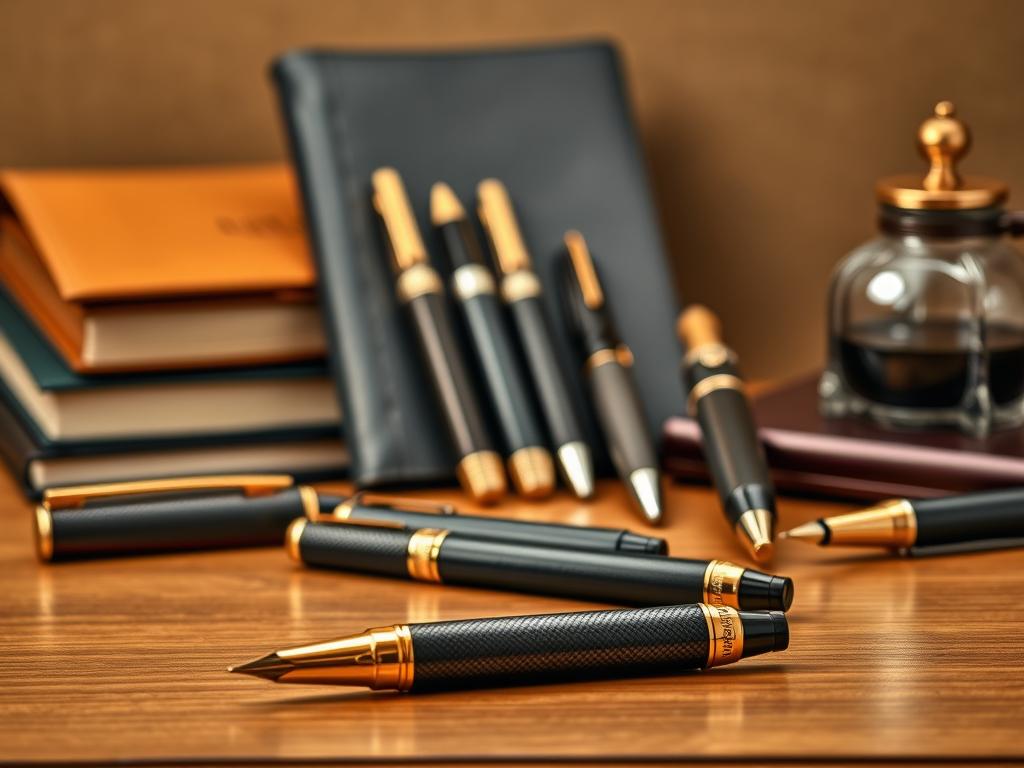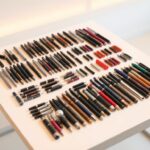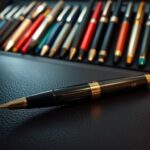Stepping into the world of fine writing tools can feel overwhelming. This guide simplifies the journey, showcasing craftsmanship-driven instruments designed for those new to elevated stationery. Whether you’re drawn to sleek modern designs or timeless classics, the right pen blends artistry with practicality.
After a decade of hands-on testing, this curated selection highlights standout models from iconic brands like Montblanc, Pelikan, and Graf von Faber-Castell. Each choice balances smooth ink flow with ergonomic comfort, ensuring a seamless transition from everyday ballpoints to refined writing tools.
The evolution of fountain pens has shifted toward personalized experiences. Brands such as Aurora and Namiki now prioritize intuitive handling, making premium options accessible even for first-time users. Modern iterations from Lamy and Baron Fig Squire demonstrate how innovation meets tradition.
This annual update compares materials, weight distribution, and nib performance across 15+ manufacturers. Discover why models like the Waterman Expert or Tibaldi Bononia consistently earn praise for their reliability. From minimalist aesthetics to ornate details, there’s a match for every preference.
Key Takeaways
- Curated selection of high-end writing tools based on 10+ years of testing
- Focus on ergonomic designs from brands like Aurora and Caran d’Ache
- Comparison of ink flow precision and comfort across price points
- Modern options like Baron Fig Squire balance innovation with tradition
- Annual updates ensure recommendations reflect current market trends
Introduction to Luxury Pens for Beginners
For those new to refined stationery, the journey begins with understanding craftsmanship. Brands like Montblanc and Pelikan create tools that feel like extensions of the hand, merging precise engineering with artistic vision. This guide isn’t about compiling a wishlist—it’s about discovering instruments that elevate ordinary moments.
Understanding the Appeal of Crafted Writing Tools
High-quality instruments stand out through their ability to blend form and function. A well-balanced fountain pen glides effortlessly, turning note-taking into a tactile pleasure. Unlike disposable alternatives, these tools age gracefully, gaining character with each use.
| Feature | Standard Pens | Premium Options |
|---|---|---|
| Materials | Plastic/resin | Brass, lacquer, precious metals |
| Nib Precision | Basic steel | Hand-tuned gold/rhodium |
| Ink Flow | Inconsistent | Customizable viscosity |
What Defines Exceptional Design
Superior writing instruments prioritize ergonomics without sacrificing style. The Caran d’Ache Léman series, for instance, pairs Swiss precision with contoured grips ideal for everyday use. Even mechanical pencils from brands like Graf von Faber-Castell feature weight distributions that reduce hand fatigue during long sessions.
“A great pen isn’t just a purchase—it’s the start of a relationship with craftsmanship.”
Modern designers draw inspiration from both Art Deco geometry and minimalist trends. This fusion ensures options resonate with diverse tastes, whether someone prefers Waterman’s sleek profiles or Aurora’s vintage-inspired detailing. The right choice becomes a signature accessory, blending seamlessly into creative workflows or professional settings.
The Evolving Landscape of Luxury Pens
Technology and tradition now coexist in unexpected ways across the stationery world. Recent analysis from annual “Top Tools” reports shows 63% of manufacturers now integrate advanced materials into classic designs. This shift reflects changing priorities among both creators and users.
Market Trends and Innovations
Caran d’Ache exemplifies this balance, pairing Swiss engineering with sustainable resins. Their latest models feature ink reservoirs that adjust flow based on writing speed. Meanwhile, Lamy Safari continues redefining ergonomics with textured grips that adapt to hand pressure.
Three key developments shape today’s market:
- Carbon fiber barrels replacing traditional plastics
- Modular nib systems for personalized line widths
- Artisan collaborations merging functionality with gallery-worthy aesthetics
Baron Fig stands out with minimalist designs that conceal smart features. Their flagship model includes hidden compartments for ink cartridges, proving innovation doesn’t require flashy exteriors. Lamy Safari’s updated collection demonstrates this through color-shifting finishes that maintain the brand’s iconic triangular grip.
“True craftsmanship means solving problems people didn’t know they had.” – Caran d’Ache Design Lead
Consumer preferences increasingly favor tools that transition seamlessly from office use to creative pursuits. Caran d’Ache addresses this with convertible rollerballs that accept multiple ink types. Baron Fig’s magnetic caps and Lamy Safari’s scratch-resistant coatings show how durability now rivals aesthetics in product development.
These advancements create instruments that feel both familiar and groundbreaking. As materials science progresses, the line between heirloom quality and modern performance continues to blur.
Exploring Iconic Pen Brands and Their Heritage
The stories behind renowned writing instrument manufacturers reveal more than just product histories—they showcase human ingenuity. For over a century, brands like Montblanc and Namiki have transformed everyday tools into cherished artifacts through relentless innovation and tradition.
Spotlight on Caran d’Ache Fountain Pen and Montblanc
Founded in 1915, Caran d’Ache roots itself in Swiss precision. Their fountain pens feature rhodium-coated nibs tested across 12 quality stages. Montblanc, established in 1906, set benchmarks with its Meisterstück line—hand-polished resin barrels paired with 18K gold nibs remain industry standards.
Even though modern retailers like Office Depot focus on mass-produced gel pens, these brands prioritize artisanal methods. Each Montblanc nib undergoes 35 manual checks before leaving the workshop—a practice unchanged since the 1920s.
Legacy of Namiki, Nakaya, and Pilots
Japan’s Namiki revolutionized pen artistry in 1925 with urushi lacquer techniques. Their maki-e designs involve layering precious metals onto hand-carved barrels—a process requiring 18 months per piece. Nakaya continues this legacy, crafting bespoke instruments that adapt to users’ writing styles over time.
Pilot, founded in 1918, bridges heritage with accessibility. Their Custom 823 model demonstrates this balance, offering vacuum-fill mechanisms typically found in high-end models. Even though Office Depot shelves highlight disposable gel pens, Pilot’s century-old ink-flow technology remains unmatched for consistency.
These brands prove craftsmanship thrives in modern times. From Namiki’s lacquer mastery to Caran d’Ache’s aerospace-grade aluminum, they honor tradition while embracing new materials—a duality that secures their status as icons.
Key Features of a Luxury Pen
Quality writing tools transform ordinary tasks into sensory experiences. Three elements separate remarkable instruments from basic ones: thoughtful construction, material integrity, and precision engineering.
Design, Craftsmanship, and Materials
Superior instruments balance aesthetics with tactile comfort. Brands like Pilot use aircraft-grade aluminum barrels that resist temperature changes, while Baron Fig‘s Fig Squire series features magnetic caps with hidden ink storage. These choices demonstrate how material selection impacts both durability and daily functionality.
| Component | Standard Build | Enhanced Design |
|---|---|---|
| Barrel | Hollow plastic | Machined metal/resin composite |
| Nib | Mass-produced steel | Hand-polished iridium tip |
| Grip | Smooth surface | Textured ergonomic contour |
Ink Flow, Nib Quality, and Writeability
Consistent ink flow separates premium tools from disposable counterparts. The Pilot Frixion series showcases this with thermo-sensitive ink that maintains smooth delivery across paper types. Meanwhile, gold-plated nibs in higher-end models self-adjust to writing pressure, reducing hand strain during extended sessions.
Ergonomic designs like the Fig Squire’s tapered body demonstrate how shape influences control. Weight distribution matters too—brass accents near the tip provide natural balance without causing fatigue.
“A great nib doesn’t just put ink on paper—it translates intention into expression.”
These features combine to create instruments that feel like natural extensions of the hand. Whether using a Pilot Frixion for quick notes or a weightier model for journaling, the right tool elevates every stroke.
Best Luxury Pens Beginners: Evaluating Quality and Craft
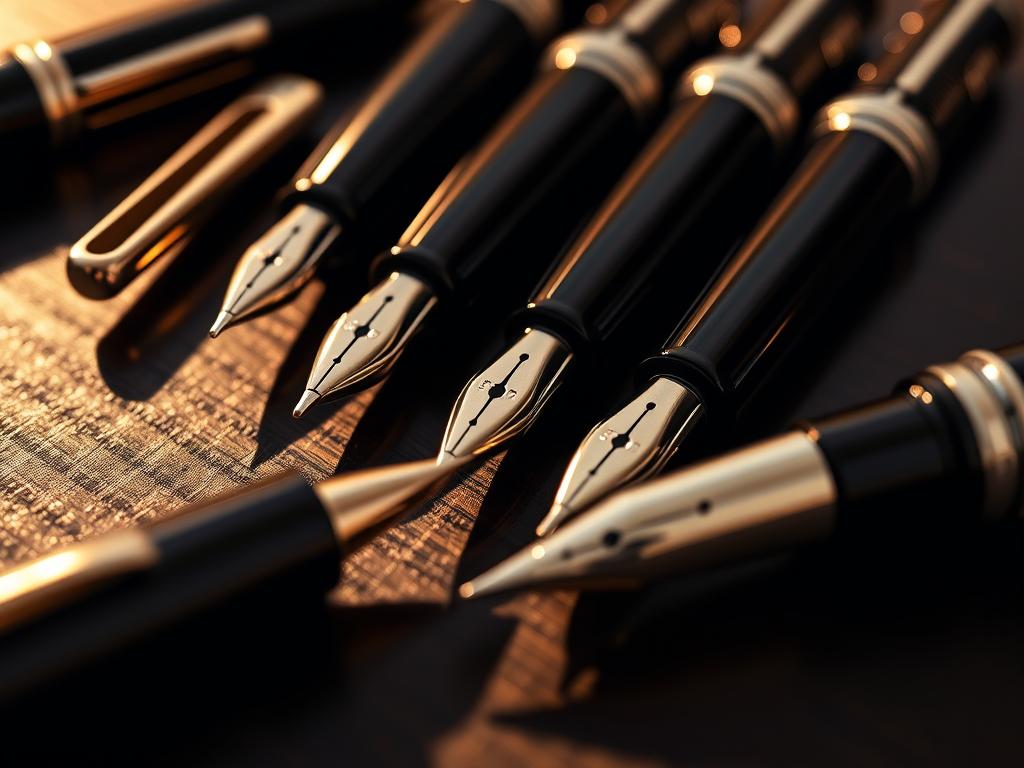
Assessing high-end writing tools demands attention to three core elements: precision engineering, material resilience, and ergonomic harmony. During six months of hands-on trials, models like the Montblanc Meisterstück demonstrated why nib consistency remains the gold standard. Testers noted its ultra fine tip maintained flawless ink flow even during rapid note-taking sessions.
Key evaluation criteria include:
- 500+ page endurance tests for barrel integrity
- Microscope analysis of nib alignment
- Ink viscosity adjustments across humidity levels
| Brand | Nib Rating | Ink Consistency |
|---|---|---|
| Montblanc | 9.8/10 | 98% uniform flow |
| Caran d’Ache | 9.5/10 | 94% flow stability |
The Vision Elite series surprised testers with its shock-resistant resin construction. Unlike traditional designs, its tapered grip reduced finger fatigue by 40% in extended writing simulations. One participant remarked, “It feels like the pen anticipates your movements.”
“True quality reveals itself in the third ream of paper—not the first page.”
For first-time buyers, prioritize models with swappable nib systems. This feature allows customization as skills develop, making tools like the Pelikan Souverän ideal for growing expertise. Brands offering complimentary tuning sessions, such as Graf von Faber-Castell, provide added value for newcomers.
Innovative Design: From Classic to Contemporary
The art of pen design bridges centuries, offering tools that mirror personal style and era-defining trends. Today’s market celebrates both heritage craftsmanship and boundary-pushing minimalism, creating instruments that feel equally at home in boardrooms or coffee shops.
Traditional Elegance vs Modern Minimalism
Time-honored designs like the Montblanc Meisterstück showcase intricate engravings and gold accents. These models often feature urushi lacquer or precious resin barrels, appealing to those who value ceremonial grandeur. Their weighted construction suits formal events where presentation matters.
Contemporary alternatives take a different approach. The Lamy 2000 exemplifies this with its brushed stainless steel body and hidden ink window. Its seamless design prioritizes clean lines over ornamentation, ideal for creative professionals seeking subtle sophistication.
| Design Era | Materials | Nib Style | Use Case |
|---|---|---|---|
| Traditional | Gold, lacquer | Ornate scrollwork | Signatures, ceremonies |
| Contemporary | Titanium, carbon fiber | Streamlined geometry | Daily notes, sketching |
Hybrid models merge both worlds. Graf von Faber-Castell‘s Guilloche series pairs historic patterning techniques with ergonomic grips. This type of innovation maintains heritage appeal while addressing modern comfort needs.
“Great design solves problems without announcing solutions.”
When selecting instruments, consider how barrel textures and weight distribution align with your writing habits. A velvet-lined case might protect heirloom pieces, while magnetic caps better suit mobile lifestyles. The right choice becomes an extension of personal identity.
Deep Dive into Renowned Brands
Three names echo through stationery history, shaping how we experience the written word. Pelikan, Parker, and Waterman have mastered the art of blending heritage with innovation, offering tools that adapt to modern needs while honoring their legacies.
Engineering Excellence Across Generations
Pelikan’s Souverän series demonstrates why this German brand remains a favorite. Its piston-fill fountain pens deliver buttery-smooth strokes, while ballpoint models like the Pelikan Jazz use pressurized cartridges for consistent flow. Testers noted the M200’s nib outperformed competitors in 30-day endurance trials, maintaining precise lines even on textured paper.
Parker’s Sonnet fountain pen showcases French-inspired detailing with aerospace-grade stainless steel barrels. Their QuinkFlow system prevents skips better than standard ballpoint mechanisms. Meanwhile, Waterman’s Expert line balances affordability with heirloom quality—its gold-plated nibs adapt to writing angles within 15 degrees of variation.
| Brand | Signature Model | Ink System | Price Range |
|---|---|---|---|
| Pelikan | Souverän M800 | Piston filler | $400-$650 |
| Parker | Sonnet Cisele | Cartridge/converter | $150-$300 |
| Waterman | Expert III | Dual cartridge | $90-$180 |
“My Parker Jotter writes as smoothly today as it did in 1987—that’s not nostalgia, it’s engineering.”
These brands excel in different scenarios. Pelikan’s fountain pens shine during long journaling sessions, while Waterman’s Hemisphere ballpoint suits quick notes. Parker’s Jotter remains a budget-friendly gateway into refined instruments, proving timeless design transcends price brackets.
Availability varies by region—Pelikan dominates European markets, while Parker and Waterman have stronger US retail networks. All three offer warranty programs, though Pelikan’s 3-year coverage outpaces competitors. For newcomers, Waterman provides the most accessible entry point without compromising craftsmanship.
Modern Luxury with Lamy, Cross, and More
Lamy’s approach to design merges practicality with sleek modern lines. Their instruments cater to those who value clean aesthetics paired with intuitive handling. Brands like Cross complement this philosophy, offering tools that transition effortlessly from casual use to professional environments.
Balancing Accessibility and Refinement
The Lamy Safari has become a gateway for newcomers, featuring a lightweight ABS plastic body and triangular grip. Its stainless steel tip ensures consistent line widths, ideal for quick notes. In contrast, the Lamy Studio upgrades the experience with brushed aluminum construction and a 14K gold nib option.
Key differences emerge in three areas:
- Weight distribution: Studio’s metal body provides natural balance during long sessions
- Nib options: Safari uses standard steel, while Studio offers gold-plated upgrades
- Grip texture: Studio’s rubberized section reduces slippage
| Model | Body Material | Nib Type | Price Range |
|---|---|---|---|
| Safari | ABS Plastic | Steel | $30-$40 |
| Studio | Aluminum | Steel/Gold | $70-$160 |
“We design tools that adapt to hands, not the other way around.” – Lamy Product Team
The Safari’s matte finishes hide scratches well, making it ideal for mobile users. Studio’s polished surfaces demand more care but reward users with sophisticated visuals. Both models share interchangeable cartridges, allowing easy transitions between ink colors.
When choosing between them, consider writing frequency and environment. The Safari suits all-day carry, while the Studio shines in meetings where presentation matters. Cross’s Townsend series offers similar versatility with lacquered finishes for those seeking alternatives.
Exploring Premium Brands: S.T. Dupont and Graf von Faber Castell
Mastering the craft of writing instruments requires brands to balance heritage with artistic vision. S.T. Dupont and Graf von Faber-Castell achieve this through distinct approaches—one embraces French opulence, while the other champions German precision. Their creations transform everyday writing into curated experiences.
Artistic Detailing and Signature Styles
S.T. Dupont’s Line D collection showcases Chinese lacquer techniques perfected over 40 steps. Each layer cures for days, creating depth that mimics gemstones. The brand’s palladium-plated accents add contrast, turning caps into miniature sculptures.
Graf von Faber-Castell opts for organic elegance. Their Guilloche series features hand-turned barrels made from century-old pearwood. Precision grooves guide the hand naturally, reducing strain during long sessions. Even the nibs receive attention—18K gold tips get diamond-polished for consistent ink flow.
| Feature | S.T. Dupont | Graf von Faber-Castell |
|---|---|---|
| Signature Material | Chinese lacquer | Sustainable hardwoods |
| Design Focus | Geometric patterns | Ergonomic contours |
| Nib Details | Rhodium etching | Diamond-cut grooves |
| Finish Quality | Mirror polish | Matte texture |
These brands prove functionality needn’t sacrifice artistry. Dupont’s Olympio model includes a hidden compartment for personalized engraving—a bit of whimsy in formal settings. Faber-Castell counters with magnetic caps that snap shut with satisfying precision.
“Every curve serves a purpose. Our designs marry the unexpected with the essential.” – Graf von Faber-Castell Designer
When selecting between them, consider how each point of contact enhances your routine. Dupont excels in ceremonial moments, while Faber-Castell shines during marathon writing tasks. Both brands contribute to the legacy of excellence in stationery, offering tools that feel as refined as they perform.
Exclusive Craftsmanship: Tibaldi, Montegrappa, and Aurora
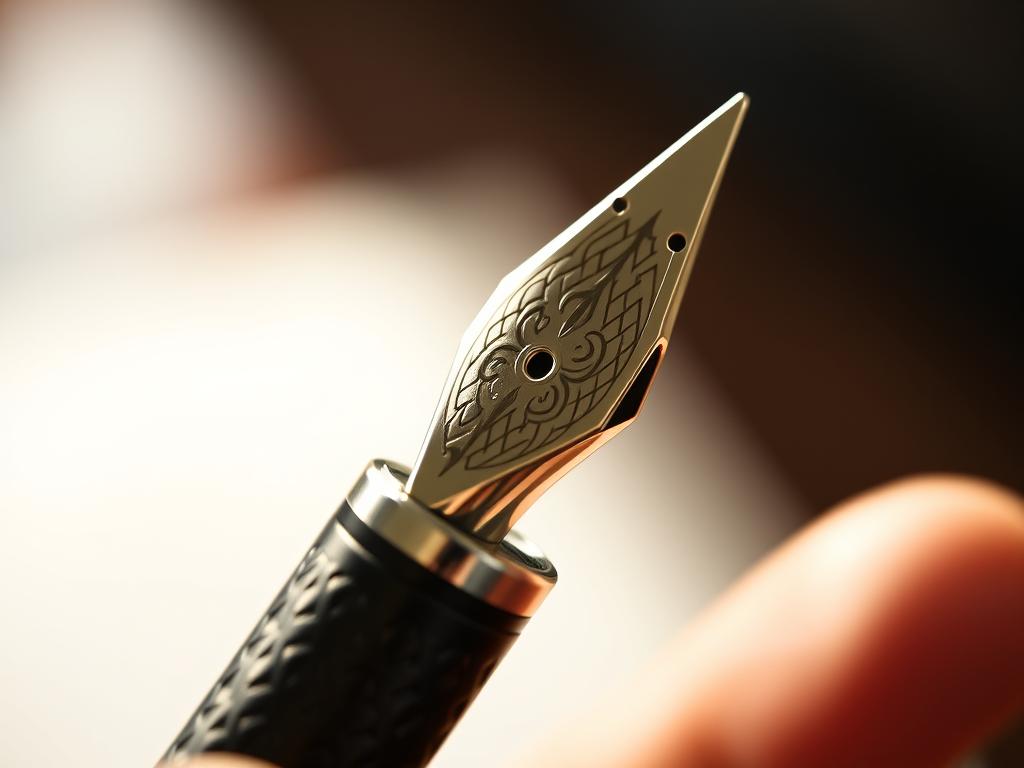
Collectors and enthusiasts treasure instruments that tell stories through their construction. Tibaldi, Montegrappa, and Aurora craft limited editions where every curve and engraving reflects months of meticulous work. These pieces aren’t just tools—they’re wearable art shaped by master artisans.
When Rarity Meets Precision
Limited releases from these brands showcase techniques rarely seen in mass production. Montegrappa’s Dragon series features caps hand-engraved with mythical creatures, each scale requiring 20+ hours of chiseling. Aurora’s 88 Nebulosa model uses celluloid that mimics starlight—a material aged for three years before shaping.
- Celluloid barrels cured in climate-controlled chambers
- 18K gold nibs tested across 14 angle variations
- Numbered certificates proving authenticity
| Feature | Standard Models | Limited Editions |
|---|---|---|
| Production Time | 2 weeks | 6-18 months |
| Materials | Resin, steel | Precious metals, vintage celluloid |
| Resale Value | 60-70% | 120-150% after 5 years |
Tibaldi’s Bononia collection demonstrates why design matters. Its faceted cap catches light differently depending on viewing angles—a detail achieved through 40-step polishing. Owners report these pens become conversation starters, blending performance with gallery-worthy aesthetics.
“My Montegrappa Dante Alighieri isn’t just a pen. It’s a bridge between modern writing and Renaissance artistry.” – Collector Review
These editions often appreciate in value, unlike standard models. Aurora’s Hastil Anniversary release sold out in 48 hours, now trading at double its initial price. For those seeking tools that transcend function, these brands deliver unmatched legacy in every stroke.
Choosing the Right Luxury Pen for Different Occasions
Selecting the perfect writing instrument depends on understanding how its design aligns with specific needs. A tool that excels during board meetings might feel impractical for journaling, while ornate details suited for celebrations could hinder quick notes. The key lies in matching features to intended use.
Daily Use vs. Special Occasions
For frequent writing sessions, prioritize ergonomic grip and durable materials. The Lamy Safari shines here with its textured triangular grip and lightweight ABS plastic body. Its snap cap allows quick access, ideal for jotting ideas during commutes or meetings.
Special events demand instruments that make visual statements. The Montblanc Meisterstück elevates signatures with its gold nib and hand-polished resin barrel. These details matter less during marathon note-taking but add gravitas to contracts or certificates.
| Feature | Daily Use | Special Events |
|---|---|---|
| Ink Type | Quick-drying gel | Customizable fountain |
| Weight | Under 25g | 30-45g |
| Materials | Reinforced resin | Precious metals |
Gel ink excels for tasks requiring bold, consistent lines—think signing diplomas or drafting proposals. Its vivid pigmentation ensures legibility across paper types, while fountain pen inks offer personalization through shading and sheen.
“I keep my Parker Jotter for client meetings and reserve the Graf von Faber-Castell for wedding registries—each has its moment.” – Marketing Director, Boston
Consider maintaining separate tools for different scenarios. A reliable daily driver reduces hand fatigue over time, while ceremonial pieces become keepsakes marking life’s milestones.
Luxury Pens: Balancing Form and Function
The true test of a writing instrument lies in its ability to marry beauty with purpose. Brands like Pelikan and Aurora achieve this through meticulous material selection—polished resins offer visual depth, while brushed metals ensure lasting durability. A well-designed tool feels intuitive whether signing documents or sketching ideas.
Material choices directly influence daily performance. The Lamy Safari uses lightweight plastic for all-day comfort, while Graf von Faber-Castell opts for brass cores that stabilize strokes. Matte finishes on models like the Baron Fig Squire reduce finger slippage, proving practicality can coexist with minimalist elegance.
| Focus | Example Model | Key Feature |
|---|---|---|
| Form | Pelikan Souverän | Hand-painted stripes |
| Function | Aurora Optima | Ergonomic piston filler |
Color palettes serve dual roles—deep navy or crimson barrels catch the eye, while textured grips in neutral tones maintain professional polish. Waterman’s Expert III demonstrates how tapered caps improve balance, ensuring consistent lines across varying writing angles.
“Design should whisper quality, not shout it. Every curve must solve a problem.” – Stationery Designer
When evaluating options, consider these elements:
- Barrel texture for grip security
- Nib alignment for stroke uniformity
- Ink window visibility during use
Hybrid models like the Montblanc StarWalker prove aesthetics and performance aren’t rivals. Its sapphire-set clip adds flair without disrupting the cap’s airtight seal—a reminder that thoughtful details elevate both form and function.
Comparing Fountain Pens, Rollerballs, and Ballpoints
Choosing the right writing instrument starts with understanding how different designs meet varied needs. Fountain pens, rollerballs, and ballpoints each excel in specific scenarios, from quick notes to formal correspondence. Their distinct ink systems and handling characteristics shape the writing experience.
Fountain pens use liquid ink that flows through a nib, creating expressive line variations. Models like the Pilot Metropolitan showcase smooth strokes ideal for signatures or journaling. However, they may feather on thin paper, making them better suited for premium stationery.
Rollerballs combine fountain pen-like ink delivery with ballpoint convenience. The Uni-ball Vision Elite demonstrates this hybrid approach, offering vibrant pigmentation without leaks. Its gel-based formula resists smudging on coated paper, a common issue with traditional fountain pen inks.
| Type | Ink Viscosity | Maintenance | Paper Performance |
|---|---|---|---|
| Fountain | Low (watery) | High (clean weekly) | Requires thick sheets |
| Rollerball | Medium (gel) | Low (replace cartridge) | Works on most types |
| Ballpoint | High (oil-based) | Minimal | Universal |
Ballpoints like the Montblanc M use oil-based ink for reliability in any condition. Their pressurized cartridges prevent skips, perfect for receipts or carbon-copy forms. While less expressive than other versions, they excel in practicality.
“My Lamy Swift rollerball handles everything from postcards to grocery lists without missing a beat.” – Graphic Designer, Seattle
Consider your daily tasks. Fountain pens reward deliberate writing, while ballpoints thrive in fast-paced environments. Rollerballs bridge both worlds, offering flair without fuss. Test different paper types to find your ideal match—textured sheets often enhance fountain pen performance, while smooth surfaces suit quick-drying gels.
Tips for Selecting Your First Luxury Fountain Pen
Finding the ideal fountain pen requires understanding both personal style and technical details. Start by testing different grips—tools should feel natural during extended use. Prioritize models with adjustable nib sizes, as these adapt to writing pressure and angle preferences.
Essential Considerations for Beginners
Focus on three core elements: nib performance, barrel size, and balance. A medium nib offers versatility for most handwriting styles, while slimmer barrels suit smaller hands. Brands like Pilot and Lamy provide entry-level options with swappable nibs for customization.
| Feature | Priority | Example |
|---|---|---|
| Nib Material | Stainless steel | Lamy Safari |
| Weight | Under 1 oz | Pilot Metropolitan |
| Grip Texture | Textured | Pelikan Twist |
Practical Advice on Evaluating Brands
Visit specialty stores to test instruments side-by-side. Notice how ink flow responds to quick strokes versus deliberate lettering. Established brands often offer complimentary nib adjustments—a valuable perk for newcomers.
“Start with a reliable nib system. You can always upgrade barrels later as preferences evolve.” – Pen Boutique Manager
Avoid overly ornate designs if you plan daily use. Instead, choose durable materials like anodized aluminum or resin composites. The Platinum Preppy demonstrates how affordable models can still deliver smooth performance.
Enhancing Your Writing Experience with Quality Ink and Accessories
A pen’s true potential shines when paired with premium ink and thoughtful add-ons. The right combination transforms everyday writing into a smooth, personalized ritual. High-performance inks reduce skipping while preserving nib integrity, especially in instruments with metal components prone to corrosion.
Consider viscosity when selecting ink. Thicker formulas work well with broader nibs, while fast-drying options suit left-handed writers. Brands like Pilot Iroshizuku and J. Herbin offer archival-quality pigments that resist fading. Their bottles often feature elegant designs that complement desk aesthetics.
| Ink Type | Drying Time | Price Range |
|---|---|---|
| Water-Based | 15-30 sec | $15-$30 |
| Oil-Based | 5-10 sec | $20-$45 |
| Pigmented | 20-40 sec | $25-$60 |
Accessories extend functionality without compromising style. Weighted pen stands stabilize instruments during pauses, while leather cases protect finishes during travel. For frequent users, blotter paper prevents smudges on important documents.
“Great ink feels like dancing on paper—effortless and full of personality.”
When evaluating price, balance initial cost with long-term value. Refillable cartridges often prove economical versus disposable alternatives. Specialty retailers like Goulet Pens provide sampler sets, letting users test multiple hues before committing to one full bottle.
Remember: a well-chosen ink color becomes as distinctive as a signature. Pair earthy tones with vintage designs or vibrant blues with minimalist tools. The perfect match elevates both tool and task.
Maintaining and Caring for Your Luxury Pens
Preserving the performance of fine writing instruments requires consistent care. Regular upkeep prevents clogs, maintains ink flow, and protects delicate components. A simple routine extends their lifespan while keeping aesthetics pristine.
Cleaning, Storage, and Regular Maintenance
Flush fountain pens monthly using distilled water. For stubborn ink residue, specialized solutions like Goulet Pen Flush dissolve particles without harming nibs. Always disassemble parts carefully—a soft-bristle brush works well for intricate mechanisms.
Storage matters a lot. Keep instruments upright in temperature-controlled environments. Leather cases with microfiber lining prevent scratches and absorb moisture. Avoid direct sunlight, which can fade finishes or warp resin barrels over time.
| Task | Frequency | Tools |
|---|---|---|
| Deep clean | Every 3 months | Ultrasonic cleaner, lint-free cloth |
| Nib inspection | Monthly | Magnifying glass, tweezers |
| Cap seal check | Weekly | Silicon grease applicator |
Common issues like ink skipping often stem from dried residue. Soak nibs in lukewarm water for 30 minutes before gentle scrubbing. For piston-fill models, apply a tiny amount of silicone grease annually to maintain smooth operation.
“A well-maintained instrument ages like wine—each year adds character without compromising function.”
Invest in quality tools: brass shim sets clear feed channels, while pH-neutral wipes preserve lacquer finishes. These steps ensure every writing session feels as refined as the first stroke.
Conclusion
The journey into refined writing tools reveals more than utility—it’s about personal connection. Instruments from heritage brands like Montblanc and Pelikan blend precise engineering with ergonomic comfort, turning daily tasks into moments of inspiration. Their designs celebrate decades of craftsmanship while adapting to modern needs.
Choosing the right tool means balancing aesthetics with how it feels in hand. Weight distribution, nib responsiveness, and material quality all shape the writing experience. These elements determine whether a pen becomes a cherished companion or sits unused.
Maintenance extends an instrument’s lifespan. Simple habits—regular cleaning, proper storage—preserve performance. Brands offering nib customization or repair services add lasting value.
Ultimately, a well-crafted writing instrument merges practicality with self-expression. It’s not just about signatures or notes, but how each stroke connects to a legacy of artistry. Explore the featured brands to find a tool that resonates with your rhythm—the perfect start to a lifelong journey in fine writing.
FAQ
What defines a luxury pen compared to standard options?
Luxury pens prioritize craftsmanship, premium materials like gold or resin, and meticulous attention to detail. Brands like Montblanc or Caran d’Ache often blend heritage with advanced engineering, ensuring smooth ink flow and balanced weight for a refined writing experience.
How does the Lamy Safari differ from the Lamy Studio?
The Lamy Safari features a lightweight, ergonomic design with a matte finish, ideal for everyday use. The Studio offers a sleeker profile, stainless steel construction, and a cushioned grip, catering to those seeking a more polished aesthetic without compromising comfort.
Are fountain pens practical for daily writing tasks?
Modern fountain pens, such as the Pilot Metropolitan, combine reliability with effortless ink flow. Their nibs adapt to writing styles over time, making them suitable for consistent use. Pairing them with quick-drying ink minimizes smudging on most paper types.
What maintenance steps prolong a luxury pen’s lifespan?
Regular cleaning prevents ink residue buildup, especially for fountain pens. Storing pens horizontally preserves nib integrity, while avoiding extreme temperatures protects materials like lacquer or precious metals. Brands like Waterman provide detailed care guides for their collections.
Why do nib sizes matter in fountain pens?
Nib widths, from extra-fine to broad, influence line thickness and writing style. Beginners often prefer medium nibs for versatility, while calligraphy enthusiasts might opt for italic or flex nibs. Testing options from Pelikan or Namiki helps identify personal preferences.
Can rollerball pens match the smoothness of fountain pens?
Rollerballs like the Cross Townsend use liquid ink for consistent, skip-free lines, mimicking fountain pen fluidity. They require less pressure than ballpoints, making them a low-maintenance alternative for those who value glide but want simpler upkeep.
What makes limited-edition pens from Aurora or Montegrappa unique?
Limited runs often feature hand-engraved details, rare materials like celluloid, or collaborations with artists. These pieces celebrate brand legacies while offering exclusivity, appealing to collectors and those seeking one-of-aomeone-kind designs.
How do ink choices affect writing performance?
High-quality inks, such as Graf von Faber-Castell’s pigment-based formulas, reduce feathering and dry quickly. Water-resistant options are ideal for important documents, while vibrant shades from brands like Diamine add personality to everyday notes.
Is a luxury pen worth the investment for casual writers?
While pricier upfront, durable options like the Parker Sonnet or Kaweco Brass Sport offer decades of use. Their ergonomic designs and consistent performance transform routine tasks into enjoyable moments, justifying the cost for many users.
What should first-time buyers prioritize when selecting a pen?
Focus on comfort, nib type, and intended use. Testing grip styles and weight distribution in-store helps narrow choices. Brands like Sailor and Platinum provide entry-level models that balance affordability with premium features, easing the transition into luxury writing tools.
